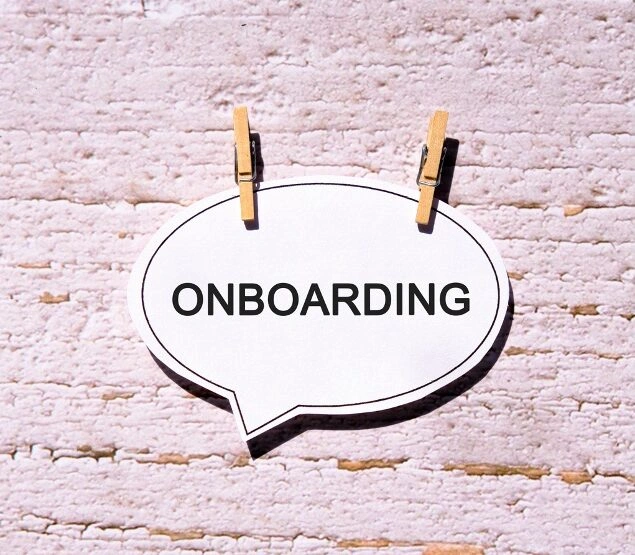
Series: What Early Stage Founders Need to Know About Hiring
In part three of the series on hiring, we delve into the world of onboarding and review what a good onboarding process looks like. As a startup founder, this process is crucial to get right. It sets the tone for your new hire’s experience and helps build your company culture.
A good onboarding process will help you to stay organized, legally compliant, and ensure your new hire feels welcomed. I’ll break down why onboarding matters and share tips for creating a smooth internal process that’ll make everyone’s life easier.
You’ve spent countless hours and thousands of dollars recruiting your first employees. You’ve successfully sold your dream, and have a few A-players helping you build it. Onboarding them was pretty scrappy, and some crucial paperwork may have slipped through the cracks. But it didn’t matter—they signed up for that!
However, things have evolved, in a good way, and it’s time to hire more people. The difference now is that you have a dozen or more positions to fill by the end of the quarter, or year. And given the hefty price tag associated with hiring, the “here’s your laptop, let’s code” onboarding process that worked for the first engineers won’t cut it anymore. It’s imperative to retain the top talent you spent thousands of dollars reeling in.
One of the most effective ways to ensure they stick around is through a good onboarding process. A positive experience sets the tone for their entire journey with your company.
A good onboarding process serves two primary purposes. Firstly it helps retain those A-players you invested considerable resources in recruiting. The goal here is to welcome them warmly, integrate them effectively, and provide the training necessary to set them up for success.
Think about it – when someone feels valued and supported from day one, they are more likely to be engaged, motivated, and committed to their new role. If they learn zilch and struggle to buy into your vision and culture, they’re more likely to take their talents elsewhere. Probably somewhere with better snacks.
Secondly, a good onboarding process ensures your company remains compliant with legal requirements and mitigates potential risks.
The good news is you don’t need to be a post-series B company with a full-fledged HR department to have an effective onboarding process. In fact, by properly integrating and therefore retaining the top talent you worked hard to recruit, you might find yourself better positioned to secure that next round of funding.
Onboarding is a comprehensive process that extends beyond paperwork and payroll setup. While external processes handled by payroll systems like Gusto are essential for legally onboarding employees, there are numerous internal processes that demand equal attention.
Compliance with federal and local government policies, as well as providing the required notices, is crucial to onboarding. In the United States, the requirements for hiring and doing business differ by state. Understanding location-specific regulations is crucial for ensuring a smooth onboarding experience.
Payroll systems will not handle all these processes for you. I discussed these location-specific requirements in greater detail in part two of this series on hiring.
Regardless of your company’s structure – a traditional office with on-site employees, a hybrid environment of remote employees, or a globally distributed team managed through an employer of record (EOR) – you need a good onboarding workflow. This will ensure all necessary tasks are completed efficiently and all required forms are signed and submitted promptly.
The better the onboarding process, the more protected the business is legally and the more valued your new hires will feel. An investment that will pay off when you require their assistance recruiting and interviewing prospective team members.
But don’t worry, it doesn’t need to be extravagant or over-the-top. You’re not Google, after all.
The key is to keep it structured, informative, straightforward and welcoming.
If you manage a small or early stage business, things are a bit scrappy when it comes to onboarding. Though there’s no shortage of excellent and comprehensive HRIS tools out there, including Bamboo HR, Rippling, or Deel, to name a few. Many include tools well beyond onboarding, such as payroll, employee handbook templates, document management systems and even talent acquisition capabilities.
G2 is a great resource for comparing them in detail.
But here’s the thing – HRIS systems are quite robust and generally designed for larger companies with deeper pockets and more headcount. Furthermore, unless you have an HR or Ops lead on your team, investing the significant amount of time and resources required to research and then implement such a system may not be the most efficient use of your time in the early stages.
Frankly, you would be paying a premium for features you’re not likely to use until a later stage. What’s the point of having a top-notch onboarding platform if your product isn’t built or hasn’t achieved market fit yet?
So, it is wise to hold off until you’re sure about a couple of things:
It’s not complicated. But does require an upfront time investment to put the process together. You need to ensure the right legal paperwork is included in your new hire packet, check all compliance boxes, and be thoughtful about adding a personal touch with your new hires. After all, no one gets warm fuzzies from generic emails sent by an automated system.
A well-structured workflow with clear step-by-step instructions and proper linking can significantly reduce errors, ensuring tasks are completed efficiently and consistently.
Additionally, centralizing this process in an easy-to-use platform like Google Sheets, Notion, or Asana will simplify navigation by creating a single source of truth. Since these platforms are widely used, most HRIS systems are designed to connect with and export data from them, saving time and resources.
Once the workflow is built, it becomes repeatable and generally requires little maintenance beyond regulatory compliance updates. The initial effort invested in creating a streamlined workflow will pay dividends when implementing an HRIS system, as much of the required information will already be organized, making the implementation process faster and simpler.
Look, I get it. You’re laser-focused on building your product, as a result operational stuff can feel like a distraction.
But here’s the harsh truth: as a founder, hiring the right people should be at the top of your priority list. A solid onboarding process isn’t just a nice-to-have; it’s a game-changer.
When you onboard new employees smoothly and get them up to speed quickly, your whole team becomes more productive, more aligned, and more likely to stick around. Plus, following a consistent process for each hire means you’re not scrambling or risking costly compliance omissions.
Trust me, a little upfront investment in getting your hiring and onboarding act together will pay massive dividends down the line.

Let’s take a look at what is included in a good onboarding process or workflow. The below accounts for your internal workflow as well as the external processes that your payroll system can handle.
At this point you have a better idea of what your workflow should look like. Now, let’s review some options to help you put it all together. Below, I break down three approaches you can take to get this up and running, as well as the pros and cons of each.
Grab your hard hats and let’s dive in!
You can leverage the Society for Human Resource Management (SHRM) by purchasing a membership and gaining access to a broad selection of templates. With its global reach, SHRM provides information applicable to numerous countries. Secondly, you will need to supplement what’s available through SHRM by researching the requirements set by your federal and local labor departments. They will guide you toward all the required posters, pamphlets, and programs you must share with employees.
Hire consultants to guide you. To ensure you’re checking all the legal boxes, you’ll need to engage legal and HR consultants to understand compliance requirements, sources of information, and rules about document management. Additionally, you’ll want to work with a finance professional to ensure proper account management.
Outsource it. Hire an experienced people ops or onboarding consultant with enough knowledge in all three domains to create customized workflows.
If you prefer the “DIY” approach, have a look at this post where I review some best practices for creating your own onboarding workflow. And, to save you time, I put together a simple employee onboarding checklist you can download for free. Click the link below.
You may also find this post helpful as I deep dive into key components of a new hire welcome packet and provide a detailed tutorial for building your own white-glove onboarding experience. You will also find three free downloadable onboarding templates in that post, to help you hit the ground running.
If sitting back and letting someone else handle things resonates with you, look no further – Resonate Growth can help. I’ve successfully onboarded hundreds of startup employees and can stress the importance of an efficient internal flow. A well-designed process should be user-friendly, intuitive to navigate, and ensure strict adherence to compliance regulations.
See below for more details on how Resonate Growth can support you with pre-built workflows.
Resonate Growth offers a range of well-developed and simple workflows that can be customized to suit your organizational requirements.
They’ll allow you to implement a simple internal system quickly, without a lengthy implementation process. Thus ensuring a seamless experience for new hires until you’re ready to purchase a more robust HRIS system.
You can visit our Shop and review all the instant download options we offer. However, if you prefer a more personalized solution, book a Discovery Call and let’s connect live!
Straightforward step-by-step instructions built in Google Sheets or MSFT Excel to ensure simplicity and easy integration with your future HRIS tool.
While the majority of my workflows and compliance paperwork are designed with US legal requirements in mind, the underlying internal processes can still benefit small business owners in any country.


Brenna is a former Silicon Valley operations leader turned startup whisperer, using her own battle scars and tales of victory to guide others through the land of unicorns and disruptors.